
HILLMAN WWII SCRAPBOOK
HMCS PRINCE ROBERT
Presents
6. ATLANTIC & MEDITERRANEAN 1943
COMMISSION #3 CAPT. A. M. HOPE RCN 06.06.43
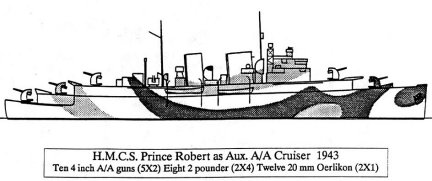


It was finally realized that with the existing armament and equipment the ROBERT was no match for armed enemy vessels. Besides, the ex-liners had a jerky and rapid roll which provided a poor gun platform without sophisticated gunnery control. Unlike her sister ships, the ROBERT was slated for the role as an anti-aircraft cruiser rather than an LSI. She was taken out of service in January 1943 and Burrard Dry Docks in Vancouver fitted her out. She was armed with ten 4-inch twin HA/LA Mark XXV guns, eight 2-pounder pompoms and twelve Oerlikon 20mm. At the same time, proper director and fire control were added. This was supplemented with some relatively modern Radar, suitable for aircraft warning, surface detection and fire control. The Asdic was also updated and four depth charge throwers added. Now the ROBERT was one of the most powerful A/A ships afloat, for her size.The ROBERT sailed for England at the end of April, travelling via Panama and Bermuda. The voyage through the canal was made memorable at Colon by the introduction of young Canadian sailors to Central American nightlife. It was no contest – the Canadians were wiped! A high class P.O.W was embarked and most available space was filled with bunches of bananas.
Arrival at the Clyde after a short stop in Bermuda saw further modifications made to the gunnery systems and the surviving bananas were generously donated to the children’s hospital in Glasgow.
The ROBERT now joined fast troop convoys to Gibraltar and return as A/A escort. The Bay of Biscay was a relatively dangerous route as the enemy were using long range aircraft as assistance to their U-boats.
By this time the Germans had established very sophisticated radio transmissions both in Spain and France to assist in the location of convoys and to enable the U-boats to home in on them. In addition, the long range Heinkel 177 bomber was able to carry two rocket-assisted flying bombs, which could be targeted by the controlling aircraft from a safe range.
In November 1943, a large Med-UK troop convoy was shadowed by hostile aircraft 250 miles WSW of Cape Vincent, Portugal. A series of U-Boat engagements over a period of four days ensued. Three submarines were destroyed and several damaged during the course of this action with no casualties to the convoy. Among the escorts the Canadian ships CALGARY and SNOWBERRY were credited with sinkings.
Discouraged with the lack of success of their U-Boats, the Germans then adopted new tactics by making strong assaults with large forces of bomber aircraft operating from bases in France. Four-engined FW200s carried out conventional bombing but the surprise threat was from HE-177s equipped with rocket-assisted, radio-controlled, flying bombs. The ROBERT arrived at the height of the action and fired everything she had for the next two and a half-hours.
Despite the ferocity of the attack, the A/A fire saved her from at least one flying bomb and held the casualties of the convoy to one ship with no personnel loss.
This was the first major air attack against Atlantic convoys in over a year and introduced new methods of anti-ship warfare. At a later date, the ATHABASKA was not so lucky under similar circumstances when a flying bomb passed through her before detonating on the other side.
Subsequently, as the armies pushed northward in Italy, the ROBERT ran convoys from Plymouth to Naples. She arrived in Naples for the first time less than a week after the city had fallen to the allies, and was the first Canadian ship into that port. A delayed action bomb had just exploded in the post office in the crowded downtown area with devastating effect. There were still many such weapons undiscovered posing a threat to those on shore.
The ROBERT was generally detached shortly before the convoys approached Gibraltar. Whether this was due to her limited cruising range, and the need to refuel, or the requirement to pick up some cases of sherry for delivery to Churchill, has never been determined. Gibraltar was usually good for at least a couple of days visit and on two such occasions, the ship’s company were honored to perform the “Ceremony of the Keys” which marked the first time such had been performed by other than a regular British regiment.
On the first cruise of this operational tour, the ROBERT was detached to Horta in the Azores. This marked the reimplementing of a treaty between Great Britain and Portugal, dating from Napoleonic times. This treaty allowed British ships to use the Azores ports in time of war. The Azores thus provided a valuable mid-Atlantic base for the anti-submarine war.
Just what function the ROBERT played in this is not clear other than “showing the flag,” but it gave the crew a few days of sun, fresh fruit, superb wines, and cheap shopping in a lush semi-tropical setting.
Back in Plymouth, which became the northern terminus for this run, the ROBERT, as an A/A ship, was called upon as a supplement to local defenses whenever an air raid took place. Latterly, the Canadian Tribals, HAIDA and ATHABASCAN used the same base for their nighttime channel forays. The loss of the latter was very keenly felt by the crew since there were naturally many friends among the lost crew.
To the disappointment of all, the ROBERT was not destined to take part in the Normandy invasion exercise since, at that time, she was laid up in Belfast with boiler trouble. She did however, continue the Naples run until the danger of A/A attack was considered minimal. She then returned to the Canadian west coast to be paid off on December 20th, 1944. Commitments for the Pacific war had been made earlier in 1944 and the ROBERT went into Burrards once again for a short refit. The crew had been away from Canada for the best part of two years.
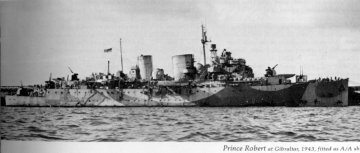
Prince Robert at Gibraltar 1943 Fitted as A/A Ship

Flying bomb attack in the Bay of Biscay
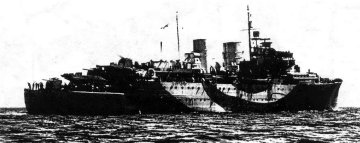
H.M.C.S. Prince Robert ~ June 1943
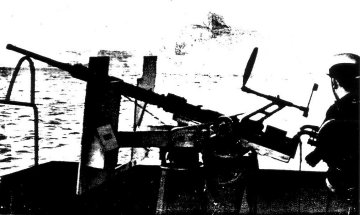
Gibraltar
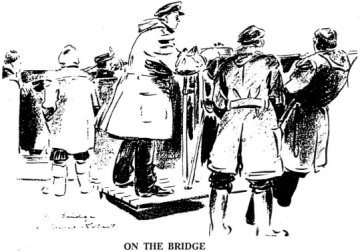
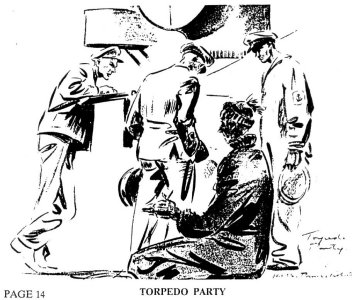



Webmaster: William G. Hillman
BILL & SUE-ON HILLMAN ECLECTIC STUDIO
Copyright 2000/2006/2017
Bill Johnson Material Copyright 1988